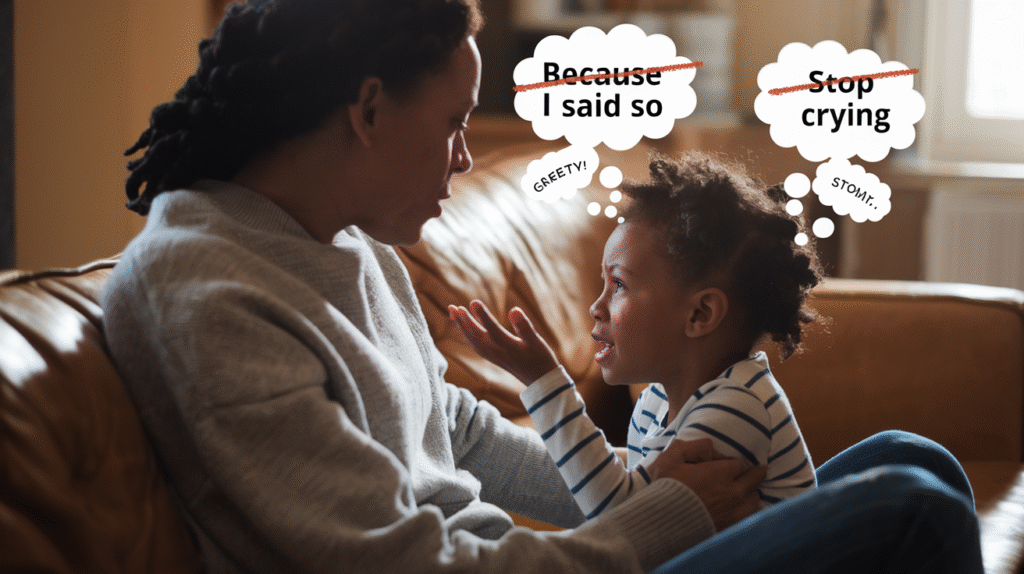
Ever found yourself in a grocery store while your three-year-old turns into a tiny tornado because you won’t buy Lucky Charms? I see those nodding heads.
Tantrums aren’t just annoying—they’re exhausting for everyone involved. Your child isn’t plotting to ruin your day (though it certainly feels that way sometimes). They’re just overwhelmed and don’t have the emotional tools to express it properly yet.
This guide offers five gentle parenting techniques to manage toddler tantrums without losing your cool or your dignity in the cereal aisle. No rigid timeout systems or bribes required.
But before we dive into these sanity-saving strategies, let’s talk about what’s actually happening in your child’s brain during a meltdown. It explains why reasoning with them is about as effective as negotiating with your houseplant.
Understanding the Root Causes of Tantrums

A. Identifying emotional triggers in children
Ever watched your little one go from perfectly happy to full meltdown in seconds? Kids have emotional triggers just like we do. Maybe your child loses it when they’re hungry (hangry is real, folks), tired, or feeling rushed. Some kids can’t handle transitions – like leaving the playground or turning off the TV. Others melt down when they feel misunderstood or ignored.
The trick is becoming a detective of your child’s emotions. Start noticing what happens right before the storm hits. Was the environment too stimulating? Did they miss their nap? Are they struggling to communicate something important to them?
B. How developmental stages affect tantrum behavior
Two-year-olds throw tantrums for completely different reasons than four-year-olds. It’s all about brain development.
Toddlers (1-3 years) have big emotions but limited language skills. They literally can’t tell you what’s wrong, so they scream instead. Preschoolers (3-5 years) are developing independence and testing boundaries. Their tantrums often revolve around control issues.
School-age kids might have more sophisticated meltdowns related to social pressures or academic frustrations. Their developing brains are still learning emotional regulation – it’s a skill that takes years to master.
C. The connection between unmet needs and outbursts
Tantrums are rarely just about wanting a cookie. They’re almost always signals of deeper unmet needs:
- Physical needs: Hunger, thirst, sleep, movement
- Emotional needs: Connection, attention, security
- Autonomy needs: Independence, control, choices
When kids feel these core needs aren’t being met, they resort to the most effective tool they have – a tantrum. It’s not manipulation; it’s communication.
D. Recognizing tantrum patterns in your child
Your child’s tantrums have unique fingerprints. Some kids have slow-building meltdowns with warning signs you can learn to spot. Others explode instantly.
Pay attention to:
- Time of day (Is it always before naptime?)
- Physical cues (Do they get red ears before losing it?)
- Situations (Does sharing with siblings always trigger problems?)
- Duration (How long do their typical tantrums last?)
Tracking these patterns gives you incredible power to either prevent tantrums entirely or handle them more effectively when they happen. Knowledge really is power when it comes to tantrum management.
Stay Calm to Calm the Storm

A. Techniques for managing your own emotional responses
When your child is in full meltdown mode, your own emotions can skyrocket. The secret? Take a quick mental step back. Count to ten silently. Remind yourself: “This isn’t an emergency. My child isn’t giving me a hard time – they’re having a hard time.”
Many parents find it helpful to have a personal mantra ready. Something simple like “I am calm” or “This will pass” can work wonders when you feel your temperature rising.
B. Using a quiet, steady voice to de-escalate situations
Your voice is a powerful tool. When you speak softly, your child has to quiet down to hear you – it’s like magic. Instead of matching their volume (which just adds fuel to the fire), drop your voice to just above a whisper.
Try this: get down to their level, make eye contact if possible, and speak in calm, short sentences. “I see you’re upset. I’m right here.” The contrast between their loud cries and your gentle tone often breaks the tantrum cycle.
C. The power of deep breathing for both parent and child
Breathing exercises aren’t just for yoga class. When tantrums hit, take a deep breath yourself first – your calm is contagious. Then guide your child: “Let’s blow out the candles” or “Let’s smell the flowers and blow the dandelions.”
For younger kids, try the “balloon breathing” technique. Have them put their hands on their tummy to feel it expand like a balloon as they breathe in, then deflate as they breathe out.
D. Creating physical and emotional safety during meltdowns
Sometimes all a tantruming child needs is a safe harbor. Create a comfortable “calm down corner” in your home with soft pillows, favorite stuffed animals, and maybe a few sensory toys like stress balls or fidget spinners.
During a meltdown, offer physical comfort if they’ll accept it. A gentle hand on their back or open arms for a hug can work wonders. If they push you away, respect their space but stay nearby so they know you haven’t abandoned them.
E. When to step back and create space
Not every tantrum needs active intervention. Sometimes stepping back (while staying present) is the kindest response. If your attempts to help are making things worse, simply say, “I see you’re upset. I’ll be right over here when you need me.”
This isn’t abandonment – it’s respecting that some emotional storms need to run their course. Just make sure your child is physically safe, then give them the dignity of working through their feelings without an audience.
Validate Feelings Without Giving In

Acknowledging emotions while maintaining boundaries
When your child is mid-tantrum, it can feel impossible to respond calmly. But here’s the thing – kids need to know their feelings matter, even when their behavior isn’t okay.
Try this: “I see you’re really upset about leaving the playground. It’s okay to feel disappointed.” Then maintain the boundary: “We still need to go home for dinner now.”
This validation is powerful because children feel heard instead of dismissed. They learn their emotions are acceptable while understanding limits still exist.
The magic happens when you get down to their level, make eye contact, and use a gentle tone. This approach doesn’t make the tantrum instantly disappear, but it creates a foundation of trust that helps over time.
Phrases that help children feel understood
Keep these phrases in your back pocket for tantrum moments:
- “You’re feeling angry because…”
- “That made you sad, didn’t it?”
- “It’s frustrating when you can’t have what you want.”
- “I understand you’re disappointed.”
- “Those are big feelings in your body right now.”
These simple acknowledgments show your child you’re on their team, even when you can’t give them what they want.
The difference between validation and permission
Validating feelings doesn’t mean permitting problematic behavior. The distinction is crucial:
Validation: “I see you’re mad your sister took your toy.”
Permission: “It’s okay to hit your sister because you’re mad.”
When you validate without giving in, you teach your child that feelings aren’t dangerous or wrong – but certain actions are still off-limits. This balance helps children develop emotional intelligence while learning appropriate boundaries.
Redirect and Distract with Compassion

Age-appropriate distraction techniques
When your little one is mid-meltdown, having a toolkit of age-appropriate distractions can be a lifesaver. For toddlers, novel objects work wonders – a special toy kept just for these moments or something unexpected like a flashlight. Preschoolers might respond to silly games (“Can you hop like a frog?”) or sensory experiences like water play.
The trick? Match the distraction to their development stage. What captivates a 2-year-old won’t work for a 4-year-old.
How to shift focus without dismissing feelings
Here’s the secret many parents miss: redirection isn’t about pretending the tantrum isn’t happening. Start by acknowledging their feelings: “I see you’re really upset about leaving the park.”
Then bridge to something new: “I wonder if your stuffed bunny at home missed you today?”
This quick validation-then-shift approach shows you hear them while gently moving energy elsewhere. Your tone matters too – stay calm and curious rather than desperate to make the tantrum stop.
Creating positive alternatives to tantrum behaviors
Kids often throw tantrums because they lack better ways to express big feelings. Your job? Teach those alternatives during calm moments.
For hitting behaviors: “Hands are for high-fives and hugs. When you’re mad, you can squeeze this pillow instead.”
For screaming: “Big voices are for outside. Inside, we can use our ‘bear growl’ voice.”
Consistently offer these swaps during tantrums: “I can’t let you throw toys. Here’s your squeezy ball instead.”
When redirection works best (and when it doesn’t)
Redirection shines during minor frustrations or the early rumbling stage of a tantrum. It’s perfect when:
- Your child is tired but fighting sleep
- They’re mildly frustrated but not fully melting down
- The tantrum trigger is something easily forgotten
But let’s be real – redirection fails when:
- Your child has legitimate grievances needing resolution
- They’re completely overwhelmed (hunger, exhaustion)
- The same issue keeps triggering tantrums (signaling a deeper need)
In these cases, connection and problem-solving work better than distraction.
Building Long-Term Tantrum Management Skills

A. Teaching emotional vocabulary for better expression
Kids throw tantrums because they’re frustrated and can’t express what they’re feeling. Makes sense, right? I’d probably lose it too if I couldn’t explain my needs.
Start by labeling emotions during everyday moments: “You look angry because your tower fell down” or “You seem disappointed we can’t have ice cream now.” When you name feelings, you’re giving your child powerful tools to use instead of screaming or hitting.
Create a feelings chart with simple faces showing different emotions. Point to them during the day: “Are you feeling like this face right now?” Kids love this visual approach.
B. Establishing consistent daily routines that prevent tantrums
Surprises are fun for birthdays—not for Tuesday mornings. Kids thrive on knowing what comes next.
Most tantrums happen during transitions or when kids are hungry or tired. Picture a simple routine chart with images showing morning steps: wake up, brush teeth, get dressed, eat breakfast. Even young children can follow visual cues.
The magic isn’t in having a perfect schedule—it’s the consistency that makes kids feel secure. When they know what’s happening next, there’s less to fight about.
C. Role-playing difficult situations during calm times
When everyone’s happy and relaxed? That’s your training window.
Try this: grab some stuffed animals and act out common tantrum triggers. “Oh no, Bear really wanted the red cup but it’s dirty! What could Bear say instead of screaming?”
This practice isn’t silly—it’s creating muscle memory for handling tough emotions. Your child is literally rehearsing better responses while in a good mood.
D. Reinforcing positive behavior with specific praise
Generic “good job” comments don’t teach much. But specific praise? That’s gold.
When your child handles disappointment well, spotlight exactly what impressed you: “I noticed how you took three deep breaths when your block tower fell. That showed real self-control!”
Kids repeat behaviors that get attention. By highlighting their emotional wins—even tiny ones—you’re building their confidence in handling difficult feelings appropriately.
E. When to seek professional support for persistent tantrums
Sometimes tantrums go beyond typical development. Trust your gut here.
Consider reaching out if:
- Tantrums regularly involve self-harm
- Your child can’t calm down after 25+ minutes
- Intense meltdowns continue well past age 5
- Tantrums severely impact family functioning
A child psychologist can offer strategies tailored specifically to your situation. And remember—seeking help isn’t failing. It’s actually top-tier parenting.

Parenting through tantrums demands patience, understanding, and the right techniques. By recognizing what triggers your child’s outbursts, maintaining your composure, acknowledging their feelings, and compassionately redirecting their attention, you can transform challenging moments into opportunities for growth. Remember that validation doesn’t mean surrendering to demands—it means showing your child that their emotions matter.
Developing long-term tantrum management skills takes time, but the investment pays dividends in your child’s emotional development. As you practice these gentle approaches consistently, you’ll notice fewer tantrums and more meaningful communication. Your calm response today helps build the emotional regulation tools your child will carry throughout life. Stay patient with yourself and your little one—you’re both learning and growing together.




